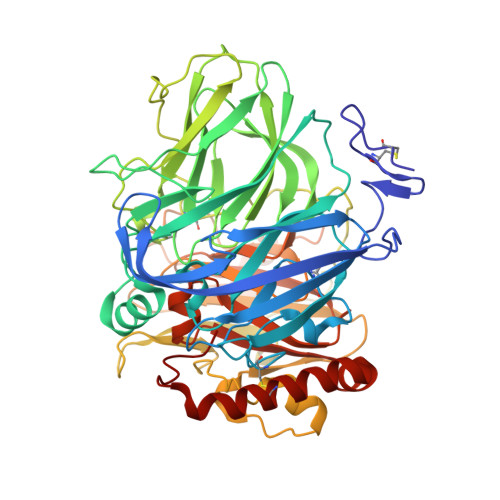A comparative structural analysis of the surface properties of asco-laccases.
Ernst, H.A., Jorgensen, L.J., Bukh, C., Piontek, K., Plattner, D.A., Ostergaard, L.H., Larsen, S., Bjerrum, M.J.(2018) PLoS One 13: e0206589-e0206589
- PubMed: 30395580
- DOI: https://doi.org/10.1371/journal.pone.0206589
- Primary Citation of Related Structures:
6F5K - PubMed Abstract:
Laccases of different biological origins have been widely investigated and these studies have elucidated fundamentals of the generic catalytic mechanism. However, other features such as surface properties and residues located away from the catalytic centres may also have impact on enzyme function. Here we present the crystal structure of laccase from Myceliophthora thermophila (MtL) to a resolution of 1.62 Å together with a thorough structural comparison with other members of the CAZy family AA1_3 that comprises fungal laccases from ascomycetes. The recombinant protein produced in A. oryzae has a molecular mass of 75 kDa, a pI of 4.2 and carries 13.5 kDa N-linked glycans. In the crystal, MtL forms a dimer with the phenolic substrate binding pocket blocked, suggesting that the active form of the enzyme is monomeric. Overall, the MtL structure conforms with the canonical fold of fungal laccases as well as the features specific for the asco-laccases. However, the structural comparisons also reveal significant variations within this taxonomic subgroup. Notable differences in the T1-Cu active site topology and polar motifs imply molecular evolution to serve different functional roles. Very few surface residues are conserved and it is noticeable that they encompass residues that interact with the N-glycans and/or are located at domain interfaces. The N-glycosylation sites are surprisingly conserved among asco-laccases and in most cases the glycan displays extensive interactions with the protein. In particular, the glycans at Asn88 and Asn210 appear to have evolved as an integral part of the asco-laccase structure. An uneven distribution of the carbohydrates around the enzyme give unique properties to a distinct part of the surface of the asco-laccases which may have implication for laccase function-in particular towards large substrates.
Organizational Affiliation:
Department of Chemistry, University of Copenhagen, Copenhagen, Denmark.
























